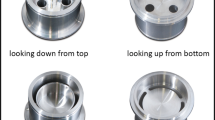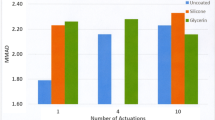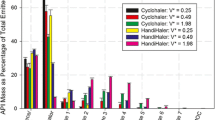Abstract
The multi-stage inertial cascade impactor is used to determine the mass-weighted aerodynamic particle size distribution (APSD) as a critical quality attribute for orally inhaled products (OIPs). These apparatuses progressively size-fractionate the aerosol passing through a series of stages containing one or more nozzles, by increasing particle velocity. Nozzle sizes for a given multi-nozzle stage can be described collectively by effective diameter (\( \overset{\sim }{W_0} \)), related to the cut-point size, providing the link to aerodynamic diameter. Users undertake stage mensuration periodically to assure that each stage \( \overset{\sim }{W_0} \) remains within the manufacturer’s tolerance, but there is no guidance on how frequently such checks should be made. We examine the philosophy that particle size-related specifications of the OIP should determine when an impactor is mensurated. Taking an example of a dry powder inhaler-generated aerosol sampled via a Next Generation Impactor with pre-separator, we find that there are only three critical stages that could have a material effect on the measured APSD specified as four groupings of stages following current regulatory practice. Furthermore, \( \overset{\sim }{W_0} \) for the most critical stage having the smallest nozzle sizes could be relaxed by a factor of four or more before risking an inability to measure the mass fraction of API in the group containing the finest particles to a specification within ± 10% of nominal. We therefore conclude that users should consider letting the specification for APSD performance of an OIP in terms of accepted stage groupings drive the impactor quality requirements and frequency that stage mensuration is undertaken.





Similar content being viewed by others
References
Mitchell J, Newman S, Chan H-K. In vitro and in vivo aspects of cascade impactor tests and inhaler performance: a review. AAPS PharmSciTech. 2007;8(4):110. https://doi.org/10.1208/pt0804110 Available at: https://www.ncbi.nlm.nih.gov/pmc/articles/PMC2750696/ Accessed September 27th 2018.
Hinds WC. Aerosol technology properties, behavior, and measurement of airborne particles. 2nd ed. New York: Wiley; 1999. p. 134–8.
Marple VA, Liu BYH. Characteristics of laminar jet impactors. Environ Sci Technol. 1974;8(7):648–54.
Dechraksa J, Suwandecha T, Maliwan K, Srichana T. The comparison of fluid dynamics parameters in an Andersen cascade impactor equipped with and without a preseparator. AAPS PharmSciTech. 2014;15(3):792–801.
United States Food and Drug Administration. Draft guidance for industry: metered dose inhaler (MDI) and dry powder inhaler (DPI) products—quality considerations. Silver Spring, MD, USA. 2018. available at: https://www.fda.gov/downloads/drugs/guidances/ucm070573.pdf , visited September 28, 2018.
Nichols SC, Mitchell JP. An assessment of the comparative efficiency of abbreviated versus full resolution cascade impactor measurements: a survey of European Pharmaceutical Aerosol Group (EPAG) members. Drug delivery to the Lungs-24. Edinburgh: The Aerosol Society; 2013. p. 237–40.
US Pharmacopeial Convention. United States Pharmacopeia 41/National Formulary 36, Chapter <601> Aerosols, nasal sprays, metered-dose inhalers, and dry powder inhalers. Rockville. 2018.
Marple VA, Roberts DL, Romay FJ, Miller NC, Truman KG, Van Oort M, et al. Next generation pharmaceutical impactor. Part 1: design. J Aerosol Med. 2003;16(3):283–99.
Marple VA. A fundamental study of inertial impactors. PhD Dissertation, Minneapolis: University of Minnesota, 1970.
Rader DJ, Marple VA. Effect of ultra-Stokesian drag and particle interception on impactor characteristics. Aerosol Sci Technol. 1985;4(2):141–56.
Roberts DL, Mitchell JP. The Next Generation Impactor (NGI™)—manufacturing control: Part 1—nozzles. Inhalation. 2016;10(2):12–9.
Nichols SC, Mitchell JP. Stimulus to revision: a rational approach to cascade impactor mensuration in a good cascade impactor practice (GCIP) environment. Pharm Forum. 2014;40(1) on line at: https://www.uspnf.com/pharmacopeial-forum, visited September 28, 2018.
Roberts DL, Romay FJ. Relationship of stage mensuration data to the performance of new and used cascade impactors. J Aerosol Med. 2005;18(4):396–413.
Mitchell JP, Nagel MW. Cascade impactors for the size characterization of aerosols from medical inhalers: their uses and limitations. J Aerosol Med. 2003;16(4):341–77.
McRobbie DW, Pritchard S, Quest RA. Studies of the human oropharyngeal airspaces using magnetic resonance imaging. I. Validation of a three-dimensional MRI method for producing ex vivo virtual and physical casts of the oropharyngeal airways during inspiration. J Aerosol Med. 2003;16(4):401–15.
Zhang Y, Finlay WH, Matida EA. Particle deposition measurements and numerical simulation in a highly-idealized mouth-throat. J Aerosol Sci. 2004;35(7):789–803.
Dunbar CA, Hickey AJ, Holzner P. Dispersion and characterization of pharmaceutical dry powder aerosols. KONA Powder and Particle Journal. 1998;16:7–45.
Hickey AJ. Complexity in pharmaceutical powders for inhalation: a perspective. KONA-Powder and Particle. 2018;35:3–13.
Marple VA, Olson BA, Santhanakrishnan K, Mitchell JP, Murray SC, Hudson-Curtis BL. Next generation pharmaceutical impactor. Part II: archival calibration. J Aerosol Med. 2003;16(3):301–24.
Mitchell JP, Sandell D, Suggett J, Christopher JD, Leiner S, Walfish S, et al. Stimulus to revision: proposals for data interpretation in the context of determination of aerodynamic particle size distribution profile for orally inhaled products. Pharm Forum. 2017;43(3) on line at: https://www.uspnf.com/pharmacopeial-forum , visited September 28, 2018.
United States Food and Drug Administration. Guidance for industry: Q8(R2)—pharmaceutical development. 2009. available at: https://www.fda.gov/downloads/drugs/guidances/ucm073507.pdf , visited September 28, 2018.
United States Pharmacopeial Convention. Product monograph for fluticasone propionate and salmeterol inhalation powder. Rockville, USP41-NF36; 2018. Available at: https://online.uspnf.com/uspnf/document/GUID-A54661A3-DF23-400A-8763-0213D19A10C6_1_en-US, visited October 15, 2018
United States Pharmacopeial Convention. Product monograph for fluticasone propionate inhalation aerosol. Rockville: USP41-NF36; 2018. Available at: https://online.uspnf.com/uspnf/document/GUID-39375AC5-C31B-4C74-AB80-75FD5D95A6A0_1_en-US, visited October 15, 2018
United States Pharmacopeial Convention. Product monograph for fluticasone propionate and salmeterol inhalation aerosol. Rockville: USP41-NF36; 2018. Available at: https://online.uspnf.com/uspnf/document/GUID-5BD2B30C-5CC9-4003-8ED1-59E4FF6B0CAF_1_en-US, visited October 15, 2018
United States Pharmacopeial Convention. Product monograph for fluticasone propionate inhalation powder. Rockville: USP41-NF36; 2018. Available at: https://online.uspnf.com/uspnf/document/GUID-A54661A3-DF23-400A-8763-0213D19A10C6_1_en-US, visited October 15, 2018
Nasr MM, Ross DL, Miller NC. Effect of drug load and plate coating on the particle size distribution of a commercial albuterol metered dose inhaler (MDI) determined using the Andersen and Marple-Miller cascade impactors. Pharm Res. 1997;14:1437–43.
Dunbar C, Kataya A, Tiangbe T. Reducing bounce effects in the Andersen cascade impactor. Int J Pharm. 2005;301:25–32.
Roberts DL. Theory of multi-nozzle impactor stages and the interpretation of stage mensuration data. Aerosol Sci Technol. 2009;43(11):1119–29.
Byron PR, Weers JG, Clark AR, Sandell D, Mitchell JP. Achieving deposition equivalence: the state of the art. In: Dalby RN, Peart J, Suman JD, Young PM, Traini D, editors. Respiratory drug delivery Europe 2017. River Grove: Davis Horwood Publishing LLC; 2017. p. 101–18.
Olsson B, Asking L. Methods of setting and measuring flow rates in pharmaceutical impactor experiments. Pharm Forum. 2003;29(3):879–84.
Roberts DL, Mitchell JP. The effect of non-ideal impactor stage collection efficiency curves on the interpretation of the size of inhaler-generated aerosols. AAPS PharmSciTech. 2013;14(2):497–510.
Zhou Y, Sun J, Cheng Y-S. Comparison of deposition in the USP and physical mouth-throat models with solid and liquid particles. J Aerosol Med Pulmon Drug Deliv. 2011;24(6):277–84.
Twomey S. Comparison of constrained linear inversion and an iterative nonlinear algorithm applied to the indirect estimation of particle size distributions. J Comput Phys. 1975;18:188–200.
Picknett RG. A new method of determining aerosol size distributions from multistage sampler data. J Aerosol Sci. 1972;3:185–98.
Nichols SC, Mitchell JP, Shelton CM, Roberts DL. Good cascade impactor practice (GCIP) and considerations for “in-use” specifications. AAPS PharmSciTech. 2013;14(1):375–90.
Roberts DL, Maidment M, Copley MA. Improved protocol for relating impactor stage pressure drop to the suitability for routine use. Drug delivery to the lungs. Edinburgh: The Aerosol Society; 2017. p. 94–7.
Williams G, Blatchford C, Mitchell JP. Evaluation of nasal inlet ports having simplified geometry for the pharmacopeial assessment of mass fraction of dose likely to penetrate beyond the nasopharynx: a preliminary investigation. AAPS PharmSciTechnol. 2018; 19(8):3723–3733
Author information
Authors and Affiliations
Corresponding author
Additional information
Guest Editors: Philip J. Kuehl and Stephen W. Stein
Publisher’s Note
Springer Nature remains neutral with regard to jurisdictional claims in published maps and institutional affiliations.
Rights and permissions
About this article
Cite this article
Roberts, D.L., Mitchell, J.P. Measurement of Aerodynamic Particle Size Distribution of Orally Inhaled Products by Cascade Impactor: How to Let the Product Specification Drive the Quality Requirements of the Cascade Impactor. AAPS PharmSciTech 20, 57 (2019). https://doi.org/10.1208/s12249-018-1276-9
Received:
Accepted:
Published:
DOI: https://doi.org/10.1208/s12249-018-1276-9




